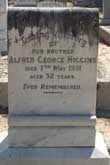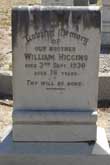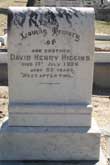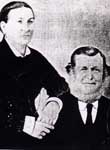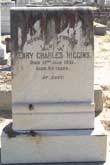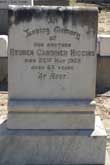| Henry William Higgins 1823 and Lavinia Gardiner 1838 | |||
| Married: 11 Apr 1854 C of E Picton, Western Australia #680 | |||
| Descendants of this family are eligible to become members of the Swan River Pioneers 1829-1838 group | |||
| Siblings 3rd Generation | |||
| Higgins | William | 1855 Springfield #2744 | 3 Sep 1930 W.A. 76yrs Never married |
| Higgins | Lavinia Susannah | 1856, Springfield W.A. #3463 | 7 Feb 1916 W.A. 59yrs |
| Higgins | Annie Eliza | 26 Apr 1858 Springfield #4217 | |
| Higgins | Susanna Maria | 1860, Springfield W.A. #5368 | 29/01/1935, Bunbury W.A. at 74 |
| Higgins | Sarah Mary | 1863, Springfield W.A. #6967 | 1866 Bunbury, W A 2yrs #3359 |
| Higgins | Reuben Gardiner | 1864, Springfield W.A. #8266 | 26 May 1928 Bunbury, W.A. 63yrs Never married |
| Higgins | David Henry | 1866 Springfield #9441 | 17 Jul 1926 W.A. 59yrs bur: Bunbury Cemetery Never married |
| Higgins | Henry Charles | 1868, Springfield W.A. #10815 | 15 Jul 1951 W.A. 84yrs Never married |
| Higgins | Martha Selina | 1870 Springfield, W.A. #12710 | 9 Oct 1948 Bridgetown, W.A. 78yrs |
| Higgins | Mary Jane | 1872 Springfield #13831 | 1894 |
| Higgins | Madeline Lisette | 1874, Capel W.A. #15918 | 7 Jun 1934 W.A. 59yrs Never Married |
| Higgins | Christiania Grace | 1876, Capel W.A. #17525 | |
| Higgins | Alfred George (Arpie) | 1878 Capel, #19392 | 7 May 1931 W.A. 52yrs bur: Bunbury Cemetery |
|
ANY FAMILY INFORMATION WELCOME |
|||
|
|
|||
|
Lavinia and Henry |
|||
|
Compiled by David Morgan Higgon, Midland Western Australia 2006 |
|||
|
Mary Jane and Martha Selina Higgens in the birth index David Henry Higgins designed the Capel War Memorial, an 11ft solid granite obelisk, opened Anzac Day 1920. In 1926 he is the member for Beelup Ward on the Wellington District Board. The Board often felt overworked and under appreciated; maybe the stress told on Dave, he died in 1926 and his place was taken by Charlie House.
Henry bought land in 1851 in
Perth (where Coles was on Hay Street-Murray Street) and sold it in
1868. The settlers disrupted the Nyungar's seasonal hunting patterns. Burning the bush to flush out kangaroos was now forbidden and much of their summer diet of fish and whales was depleted by the whalers (American and Australian). With the shortage of their traditional supplies they turned to European food such as flour and potatoes. As this diet was inadequate they used their spears sometimes on stock roaming on unfenced lands. With the belief that since the settlers killed their food e.g. Kangaroo, it was all right for them to kill the white-man's food. This incensed the farmers and there were complaints, occasional shootings and frequent arrests. One of the plaintiffs in 1851 was Henry, lessee of the property 'Paradise' on Paradise Creek. Henry and his brothers were well-known throughout the Wellington district as fine horse and cattle breeders. On one occasion, he and brother Charles chased an Aboriginal herdsman called Dorgan who they claimed was making off with 7 bullocks. Dorgan stated that he was walking peacefully along when the bullocks chased him, the more he ran away, the more they ran after him. Nobody seems to have believed the poor man and he was sentenced to 6 months in gaol. Henry and Lavinia made 'Springfield', Minninup the best farm in the
district. Undeniably the land was boggy, but Henry bought drier runs
inland where he could depasture cattle, and employed convict labour
to clear, drain and prepare 'Springfields' virgin acres for crops.
The property became well-known for its quality wheat, oats and
barley, also for its harvest of 12 tons of onions and potatoes per
acre. Horses and dairy cattle also flourished, though Lavinia
complained of cream disappearing from her dairy. She bolted the door
but still the cream vanished. Eventually Henry discovered a group of
Aborigines poking grass straws through the dairy's slatted walls and
sucking up the cream from the pans. Henry begrudged the lost pastures as the Capel River floodwaters built up and flowed out over the rich flat land towards the Wonnerup Estuary each winter, eventually topping the sand bar and spilling into the Indian Ocean. The people around the Bay called this section 'The Lakes' and everyone learned to row a boat. In 1864 he cut a channel through the sand hills to the sea. The cut was only partly successful because sometimes the sea swept back through the channel and spread salt water over the land. Henry's neighbour, James McCourt, was incensed about the cut. Apart from salt contamination, the channel ran right across the road to some of his southern properties and meant he had a long journey round to reach them. He complained loudly to the RM (Resident Magistrate) who informed Henry he was not allowed to obstruct a public right of way. Reluctantly Henry leveled the banks of the cut at one spot to allow passage, however McCourt and other travellers still had to splash their way across a fairly makeshift ford. Shortly afterwards an anonymous letter pointed out to the RM that McCourt had fenced across the line of road - severely inconveniencing his neighbours - and perhaps something should be done about that. Henry's 4 oldest sons never married, after his death they formed themselves into a company called the ‘Higgins Brothers’ and ran all their properties and enterprises as one.
Henry Higgins is claimed to have employed ticket of leave men to clear, drain and prepare Springfield for crops, but the earliest record of ticket of leavemen employed by any of the Higgins brothers is 1863. It is more likely that Henry and his brothers did most of the work themselves to establish Springfield, which became well known for its impressive harvests of onions and potatoes, and for its horses and dairy cattle. Henry's brothers Edward and Frederick, later established a property in the district called Rose Hill and Charles, who married Lavinia Higgins' sister, Mary Gardiner, in 1863,established Moulden Farm. In 1862, Western Australia experienced widespread heavy rainfall and flooding, and it was probably this event that finally prompted Henry Higgins to try and drain the part of his farmland that was inundated each year. He set about cutting a channel from his land through the sand dunes to the sea. He would have been assisted in the work by his brothers and also by ticket of leave man Thomas Williams, who was employed as a labourer at Springfield for four years, from June 1863 to June 1867. Thomas Williams (convict no.5839) had been sentenced in 1859 to ten years for horse stealing. He had arrived on the Palmerston in February 1861, and was given his ticket of leave two years later. He was awarded a conditional pardon in October 1867. At Springfield, Henry and Lavinia Higgins had thirteen children, the last, Alfred, was born in 1879, shortly before Henry died at the age of fifty-six.The older Higgins boys, William, Reuben Gardiner, David Henry and Henry Charles, formed the Higgins Brothers, and continued to live at Springfield and work their properties together. None of the boys married, and their mother and sister Madeline kept house for them. In 1891, Lavinia died and the four older brothers acquired title to the properties which comprised Wellington Locations 63, 85, 206 and 213, with a total area of 424 acres (171 ha). In 1894, William was living at Yule Station, and Reuben, David and Henry Charles bought out his quarter share of the family properties for £150.21 They, and younger brother Alfred, continued to live at Springfield with their sister Madeline. For more read the Book "Just a horse ride away" a history of Capel and its people. Available from the Shire of Capel Henry and Lavinia buried at St Marks Picton Church, Bunbury |
|||
